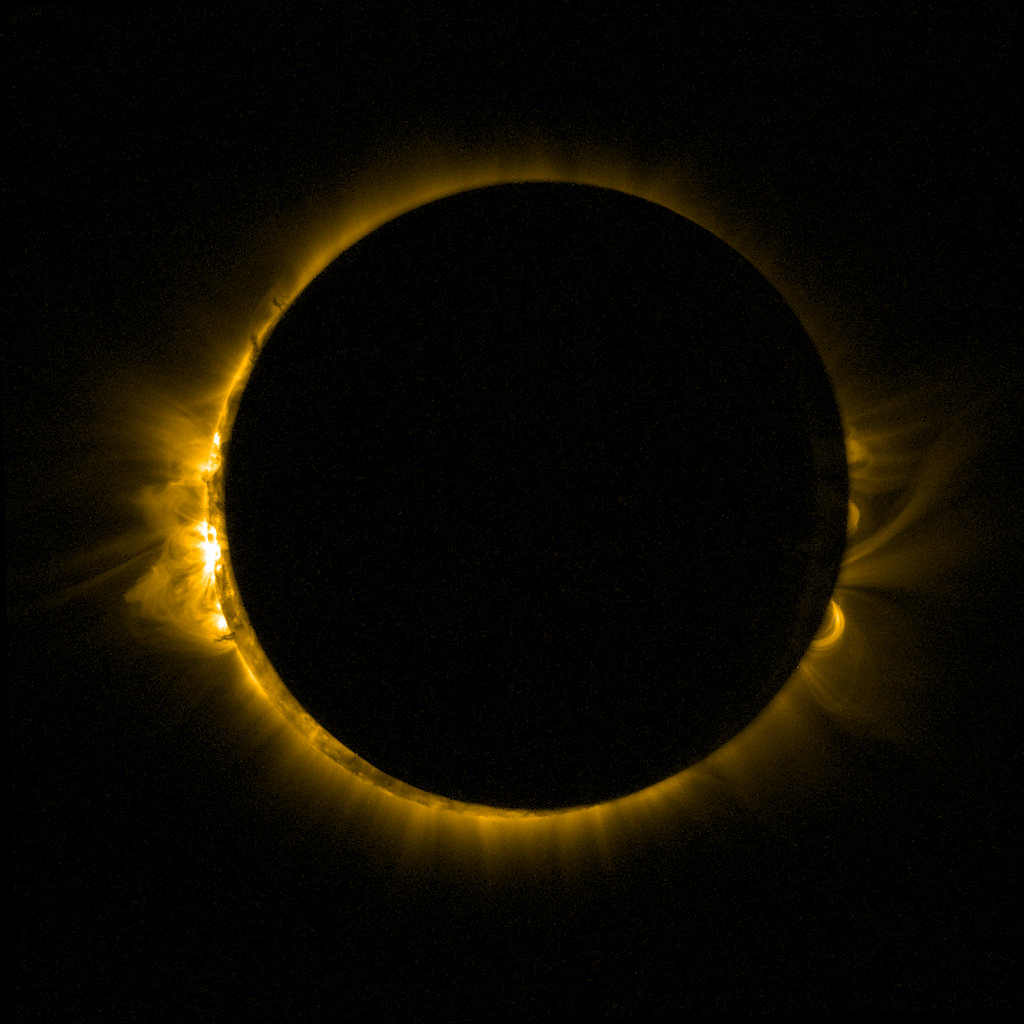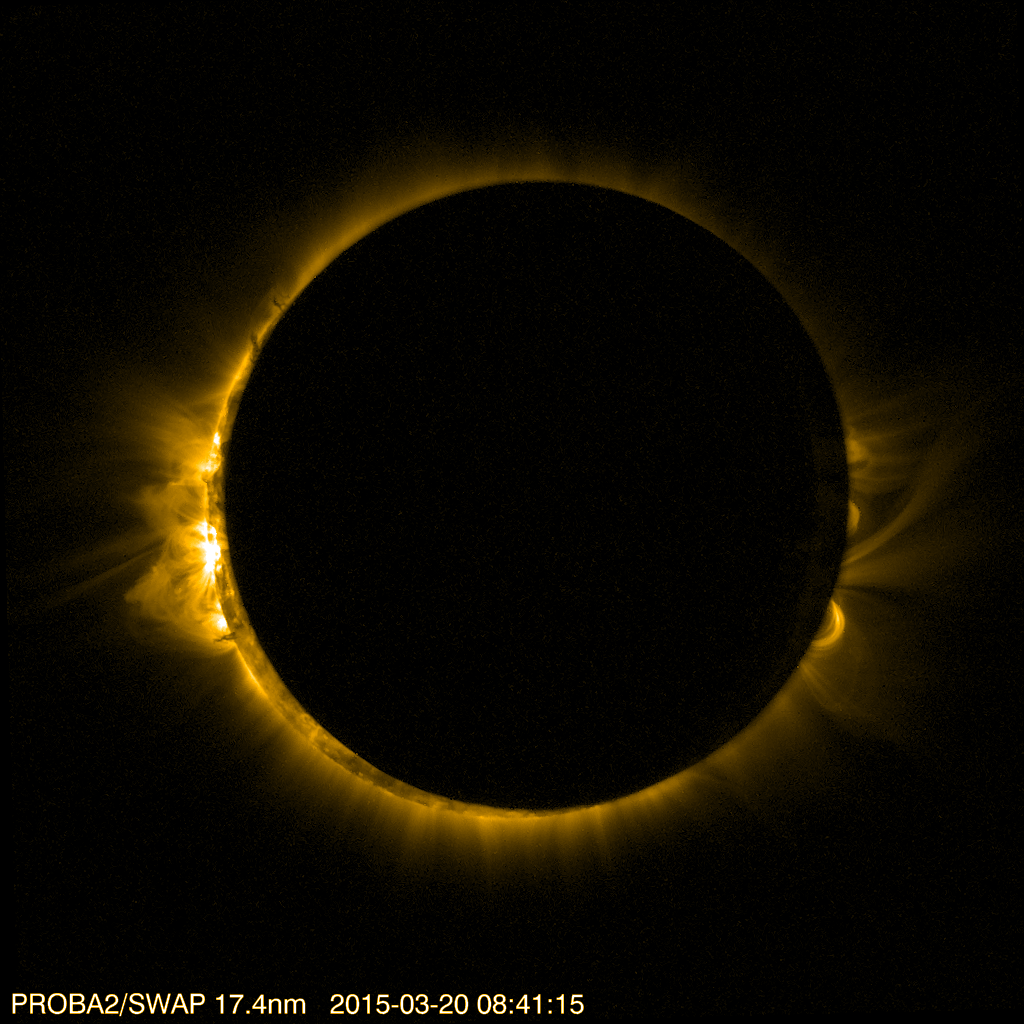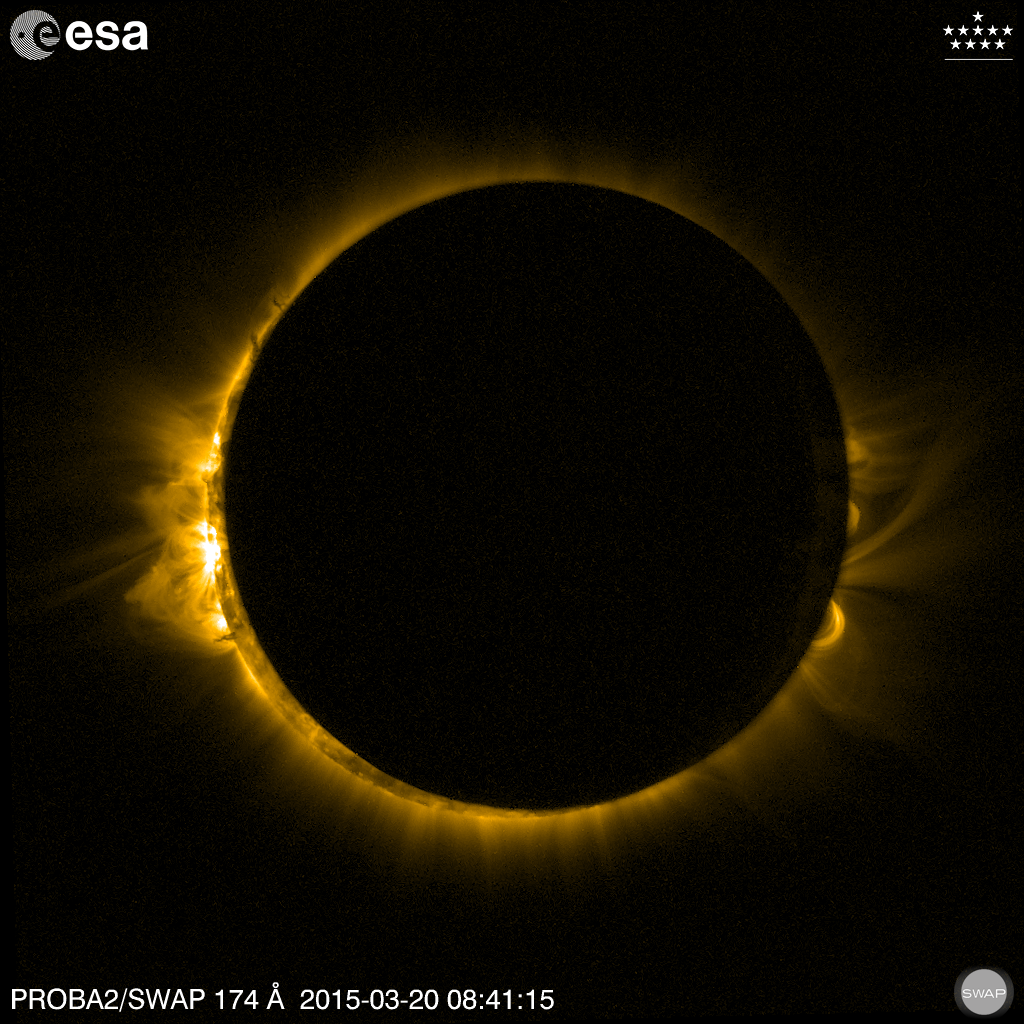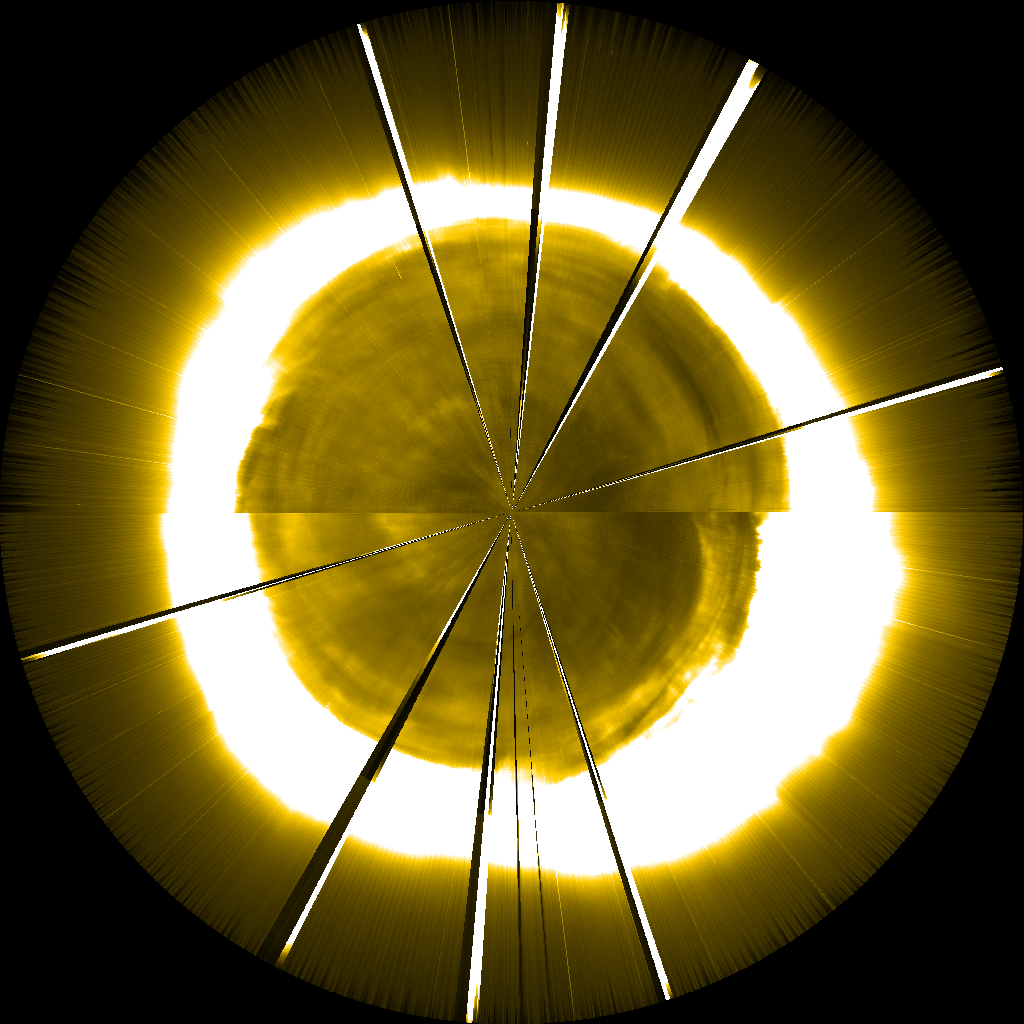Main menu
You are here
PROBA2 Views a Total Solar Eclipse - 2015
Updated (25 March 2015): On 2015 March 20, PROBA2 observed a total solar eclipse — twice! The spacecraft's orbit carried it through the darkest parts of the Moon's shadow two times, first between 08:28 and 08:53 UT and again between 10:24 and 10:50 UT. Eclipse chasers, scientists, media and members of the general public have been following our data closely, so we are collecting all of our results and data products in one place for quick access.
SWAP, an Extreme-Ultraviolet solar telescope, observes the solar corona in a passband centered on 17.4 nm. The structures we see in SWAP images have a temperature of approximately 1 million degrees. LYRA, an X-ray/Ultraviolet radiometer observes the total incoming light levels from the Sun in several wavelength bands.
More information about these instruments is available here: SWAP | LYRA.
SWAP images and movies of the eclipe are provided in three varieties: image only; image with instrument and timestamp text; and image with logos, instrument, and timestamp text. All images and movies should be credited based on the data terms of use information near the bottom of this page.
The best-available eclipse images at any point during the day, updated periodically, will appear above. These images can also be directly linked via these URLs. Readers interested in some of the more challenging details of SWAP analysis might want to read the note about the SWAP ghost effect at the bottom of this page.
- Best Image Only: http://proba2.oma.be/Events/2015-Mar-20-SolarEclipse/swap_eclipse_2015_03_20_no_labels.png
- Best Image with Timestamp: http://proba2.oma.be/Events/2015-Mar-20-SolarEclipse/swap_eclipse_2015_03_20_timestamp.png
- Best Image with Logos and Timestamp: http://proba2.oma.be/Events/2015-Mar-20-SolarEclipse/swap_eclipse_2015_03_20_logos.png
Additionally every still image from the eclipse sequence, in all three of the varieties described above, is available via this link: http://proba2.oma.be/Events/2015-Mar-20-SolarEclipse/png_sequences/
SWAP Movies of the eclipse will be updated as soon as data from the spacecraft is available on the ground. Movies will also be available in the three varieties discussed above, in MP4 format, compressed for web users and uncompressed for media users. (Media note: All movies are encoded using h264 at 25 fps. Additional encodings are available on request via the contact information at the bottom of this page.)
SWAP Movies of the Eclipse
All of the latest movies will be available at the following link. These files will be overwritten periodically throughout the day as new data arrives, so users who would like the latest/best available movie should refresh the page. Link to the movies: http://proba2.oma.be/Events/2015-Mar-20-SolarEclipse/movies/
Joint SWAP-Eclipse Observations
Frequent SWAP research collaborator Prof. Jay Pasachoff of Williams College in the United States reported that his team had a fantastic view of the eclipse from Svalbard. A composite of his eclipse image and the SWAP mosaic from this morning appears below.

An Eclipse/SWAP composite image. SWAP is gold, the eclipse image is bluish.
Image Credit: Jay M. Pasachoff and Allison L. Carter, Williams College/ESA/ROB/D. Seaton and L. Rachmeler
Our sister spacecraft PROBA-V, which observes the Earth instead of the Sun, had a fabulous view of the lunar shadow as it moved across the Earth.
Meanwhile, SWAP Co-Investigator Peter Gallagher, of Trinity College in Dublin, observed the eclipse from the air. His composite, with a SWAP image, his airborne eclipse image, and the surrounding corona seen by LASCO on the SOHO spacecraft, appears below.

A SWAP/Eclipse/LASCO composite. Eclipse image courtesy of Trinity College Dublin/University of Hawaii/Aberystwyth University/Irish Air Corps. Coronagraph image from ESA/NASA SOHO and EUV images from ESA/ROB PROBA2/SWAP.
To give observers on the ground a broad view of the corona for planning purposes, we generated a wide field-of-view mosaic image on Thursday 2015 March 19 using a series of several different off-pointing maneuvers. The individual images that make up the mosaic were taken between 02:20 and 04:50 UT. Find this mosaic here.
On the day of the eclipse, 2015 March 20, we made two more mosaics, one before (07:00 to 08:15 UT) and one after (13:35 to 14:00UT) the eclipse is seen on ground. Many observers use these images to compare the hot EUV corona we see with SWAP to the visible light corona they will observe on the ground during the eclipse. Together, the pair of images can help paint a clearer picture of the density and temperature of the corona at the time of the eclipse, important diagnostic information for scientific researchers.
 |
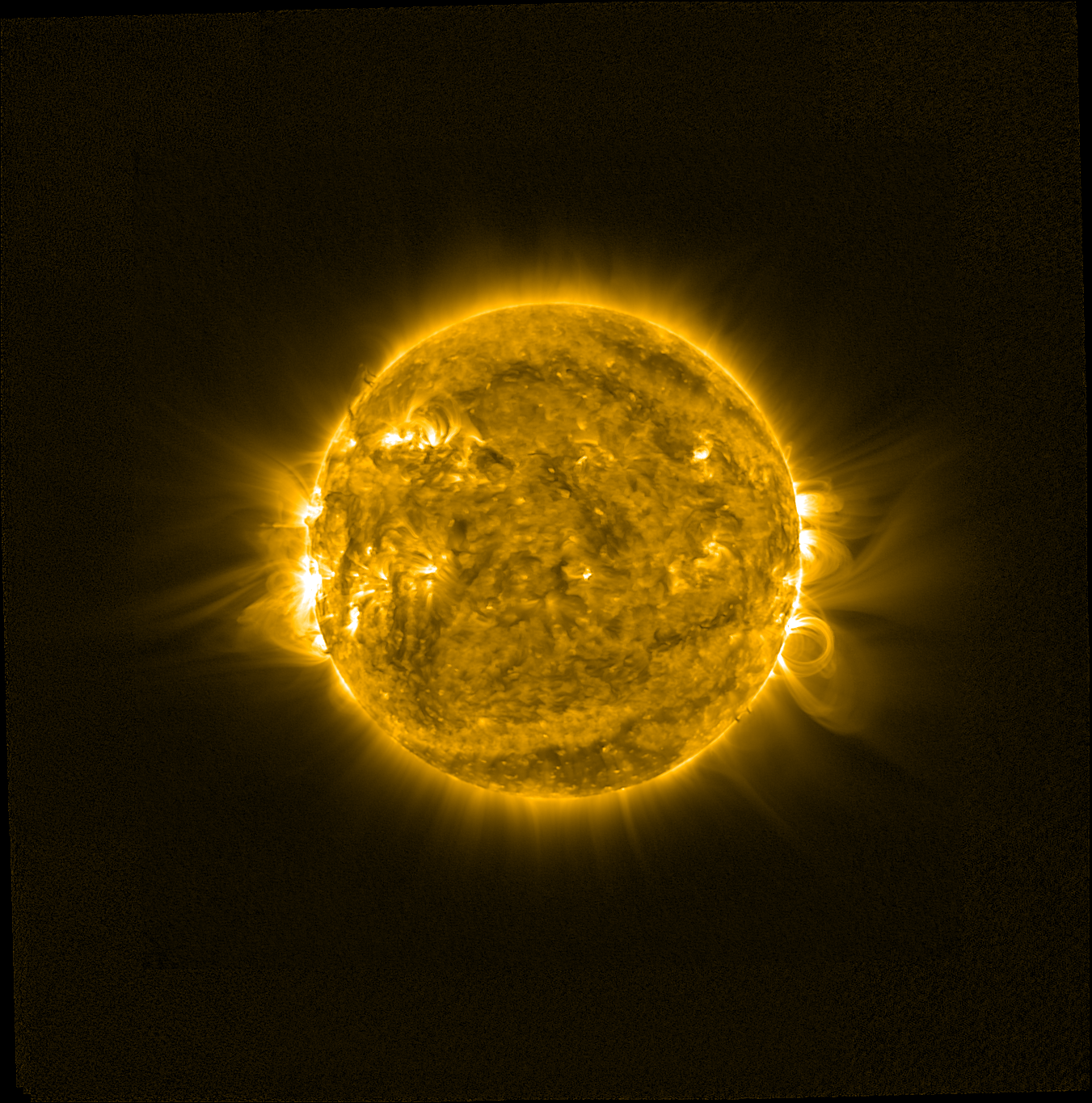 |
|
SWAP Mosaic image from 07:40 UT, 2015 March 20, just before the beginning of the eclipse. |
SWAP Mosaic image from 13:00 UT, 2015 March 20, a few hours after the end of the eclipse. |
All of our mosaic images will be available on our website as soon as we generate them via the following link: http://proba2.oma.be/Events/2015-Mar-20-SolarEclipse/mosaics/.
Between 08:15 UT and 13:35 UT, SWAP will take sun-centered images at 1 minute cadence. This data will be available on the PROBA2 website as soon as it is processed. SWAP will see two eclipses, the first at 08:28 to 08:53 UT and the second at 10:24 to 10:50 UT. Additionally, the Moon will be in SWAP’s field-of-view — but not in front of the solar disk — from 06:51 to 06:56 UT and from 12:21 to 12:30 UT.
Science data users can find uncalibrated Level-0 FITS files and calibrated Level-1 FITS files using the SWAP IDL Object. A tutorial on the use of this object is available here. Direct links to the data are also available (note that these directories will be empty before 2015 March 20): Level-0 Data | Level-1 Data.
LYRA Eclipse Science Planning
LYRA operated in its nominal mode with its high-quality backup channels active during the entirety of the eclipse. During the first transit in the eclipse zone, the usual LYRA backup unit3 was activated in parallel of the nominal unit2. But during the second transit, an exceptional campaign with the calibration unit1 was set up (again in parallel to the nominal unit). This calibration unit is rarely used for observation campaigns to preserve it at best from the processes that degrade all space instruments. Nevertheless, in this very occasion, we decided to use it to have a chance to capture the eclipse in the best observational conditions. The acquisition cadence was 20 Hz throughout the whole campaign.
Beside the usual data products and quicklooks, which are still accessible on Uncalibrated Level-1 | Calibrated Level-2 | One-Minute Average Level 3 | 3-Day Quicklooks, we produced zoom-in plots of the eclipse with the four LYRA channels. These plots are accessible from this link.
The two transits, respectively observed by unit 3 and unit 1 are plotted below. We can observe how the wavelengths the most sensitive to solar activity (black and blue) show slight distorsions with respect to the very regular drop for the channels corresponding to wavelength-ranges less affected by solar activity (red and green). Interestingly enough, small-amplitude pertubations are also visible in the black and blue curves. Those ones could be auroral effects as a geomagnetic storm was on-going.


LYRA eclipse data are usually used for analyzing how the various regions of the solar disk participate to the Extreme-Ultraviolet emission of the Sun.
Data Use Policy
All PROBA2 images and movies used in outreach and the media should be credited to "ESA/ROB". Additional information about the terms of use for PROBA2 data is available on the PROBA2 website.
Contacting the PROBA2 Team
All requests for media comments, data assistance, or planning requests can be directed to the SWAP and LYRA teams via swap_lyra@oma.be. Additional information from ROB scientists is available on the ROB Eclipse page.
PROBA2 isn't just useful for eclipse observations. You can learn about some of our biggest scientific highlights on our fifth birthday celebration page from November 2014.
A Brief Note on the SWAP Ghost Effect
Several perceptive viewers of the SWAP eclipse images and movies have noted that some parts of the the dark moon occasionally appears transparent. The moon, of course, is totally opaque to EUV light, so what can account for this apparent transparency?
To a small extent, this is due to motion blurring: Both the spacecraft itself and the Moon's shadow are moving rapidly with respect to the position of the more distant Sun in the sky. As a result, in the 10 seconds it takes to capture a single SWAP image, the Moon appears to change position relative to the Sun, creating a motion blurring effect, just like you see when snapping a traditional photograph of a rapidly moving subject. Where the Moon's apparent motion hides or reveals a portion of the sun during a single image integration, the silhouette appears somewhat transparent.
That's not the whole story, however. Another effect, called the ghost effect, comes directly from the SWAP camera itself. SWAP uses an Active Pixel Sensor (APS) camera to capture images of the EUV sun. This type of device is widely used as an image sensor in consumer devices like digital cameras and mobile phones, and SWAP's camera shares its heritage with such devices. However, SWAP was the first space-based solar telescope to use an APS detector, and as a result, the device and its application in SWAP are still somewhat experimental — like a lot of technology onboard PROBA2.
One of the side effects of the way we use our camera turns out to be that ghost images sometimes appear as the result of a transition from a bright subject in one image to a faint one in another image. The reasons for this are somewhat complicated, and, in fact, still not altogether fully understood. However, the result for the viewer is that when we observe an eclipse, the part of the image most recently covered by the moon sometimes reappears in the next image as a ghost, giving that part of the dark lunar disk a strange, semi-transparent appearance.
In normal situations, this effect is basically negligible, since we rarely see the signal level in a single pixel change so dramatically in two back-to-back images. However, during an eclipse, the brightness in any part of the image covered by the sun can change by a factor of 1000, meaning the so-called ghost effect is at its absolute worst. When our images arrive on the ground, we tune them so that they appear nice, adjusting the contrast and adding false color, for example. But the images we deliver nonetheless retain the original characteristics of the raw data image, for better or worse, including this ghost effect. It is still a small effect, and does not impact the scientific value of our images, but it is a bit strange for viewers who aren't used to the quirks of SWAP data.
This effect has been carefully studied and documented, but is not, at present, correctable. More information about the SWAP camera and the ghost effect appears in De Groof et al., Sol. Phys., 2008.

